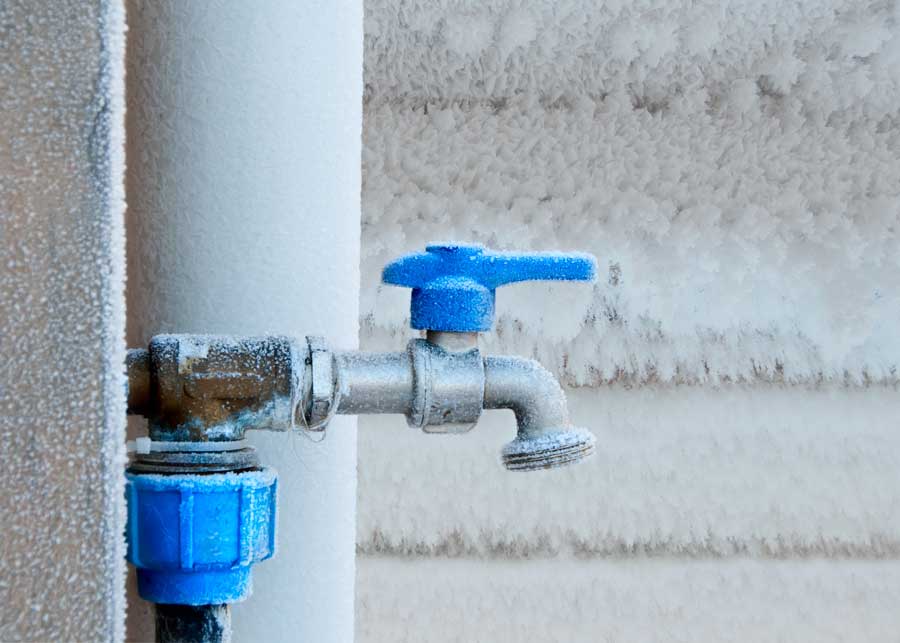Frozen pipes are an all too common annoyance that can quickly turn into costly pipe repairs and replacements if not handled correctly. Unfortunately, frozen pipes aren’t strictly a concern for cold climates either, a lot of homes that are improperly insulated can suffer from frozen pipes when a cold snap occurs.
How to Tell If Your Pipes Are Frozen
If you’ve never experienced frozen pipes, it can be challenging to know what to look for. There are some signs you can look for to determine whether your pipes are frozen, including:
- Icy residue: If you have any exposed pipes, and notice ice or a coating of condensation around the surface it is likely that the water inside your pipes is frozen in that section.
- Lack of water: When turning on a faucet produces no water, it indicates water has frozen in parts of the pipe, or worse, that a pipe has been damaged due to expanded ice.
- Strong sewer smell: You don’t expect to smell sewage when it is below freezing outside, so when this happens, it should be a warning sign to you that your sewer line is frozen, and needs to be attended to before it ruptures.
- Banging noises: Strange noises like clanging or gurgling can be a sign that your pipes did contain frozen water and the ice has been knocked loose by running water. Unfortunately, banging can also indicate damage to your heating system, so getting your plumbing system serviced regularly can help properly diagnose these noises.
Prevent Frozen Pipes at Home
Nothing is worse than coming home after a long, chilly day, only to find a lack of running water due to frozen pipes. The good news is, there are some easy and cost-efficient ways to prevent your pipes from freezing, so when a cold front comes, you’re prepared. Our experts at Bishop Plumbing, Heating and Cooling, Inc.have put together a list of 4 preventative measures you can take to ensure your plumbing system works well no matter the temperature outside.
4 ways to prevent your pipes from freezing:
- Keep the heat up: While it might feel like a waste to heat your home when you are not there, it can have surprising benefits for your pipes. You don’t need to crank the heat either. As long as your home remains above 50 degrees, it can ensure every nook of your home is heated enough to keep your plumbing stay warm.
- Turn on a faucet (or two): Again, this might feel unnecessary, but turning on a faucet or two, and allowing them to run, can relieve pressure in your pipes. So, if your pipes are partially frozen, this can prevent them from freezing completely, due to running water coming into contact with the ice. And, if your pipes are completely frozen, keeping your faucets on will reduce pressure, so your pipes will not burst.
- Open your cabinets: Pipes are often tucked in cabinets to stay out of sight. While this is an efficient and aesthetic choice most of the time, during cold snaps, it means your pipes might not be reaping the benefits of your home’s heating. Keep cabinet doors, like the ones underneath your kitchen sink, open so exposed pipes can stay warm.
- Look into insulation options: Proper insulation is your home’s first line of defense against frozen pipes. If you have experienced multiple occasions of frozen pipes, it could indicate that areas like your basement or attic aren’t insulated. Additionally, if you have decent insulation, but your home isn’t properly sealed, all that valuable heat is lost. Make sure windows and doors are properly sealed before spending money on new insulation.
Once your pipes are frozen, you are in very real danger of your pipes bursting. Many homeowners take the thawing process into their own hands, which can lead to cracks and additional damage if done improperly. Professional plumbers have the tools and techniques required to properly reheat your system safely. If you live in the Des Plaines area and need high-quality frozen pipe services, call our team today or fill out our online form.

